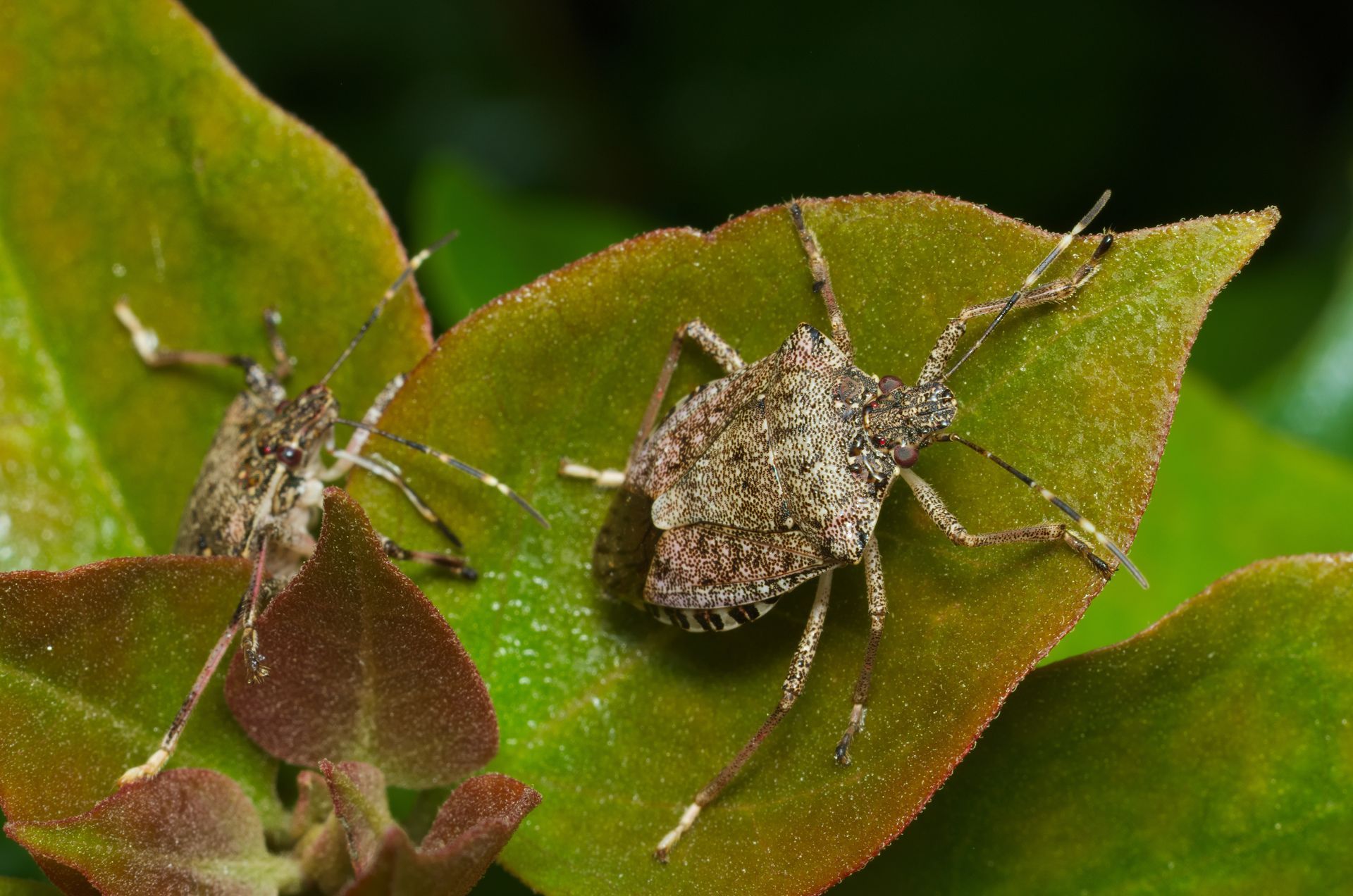Why Do Stink Bugs Stink?

As their name implies, stink bugs can release an odor that smells really bad. They produce an odor that is unpleasant as a defense mechanism to protect themselves from predators. This smell is the result of chemicals that are produced in glands that stink bugs have in their abdomen. Stink bugs can also release smells that contain pheromones that can attract other stink bugs which can prove problematic once stink bugs move inside when temperatures drop in the fall.
What Are Stink Bugs?
There are over 250 different species of stink bugs, but the most common species found in the United States is the brown marmorated stink bug. This species of bug is native to east Asia but was introduced back in the 1990’s on the east coast. Since then, marmorated stink bugs have become an invasive species that are now found all over the US. Adult stink bugs are identified by their wide shield shaped body that has a mottled or marbled pattern on its back. They are an agricultural pest that has had devastating impacts on crop yields across the US.
What Do Stink Bugs Smell Like?
Stink bugs produce a chemical within their body that when released is said to smell somewhere between cilantro or coriander and a skunk. When analyzed, the released chemical contains compounds similar to what is found in the coriander plant. This smell won’t be too impressive if produced by a singular stink bug, but the chemical contains an aggregation pheromone that attracts other stink bugs. This means that one stink bug can attract hundreds of other stink bugs to an area to nest and hibernate. When this occurs the accumulated smell of hundreds of stink bugs can become overwhelming.
What is the Main Reason Stink Bugs Stink?
Stink bugs are unable to defend themselves in other ways so stink bugs rely on their smell to act as a deterrent against predators who may look at them as a snack. This defense mechanism is typically effective against predators like birds, fish, and reptiles who have sensitive olfactory senses. Some species of stink bugs even have the ability to spray the chemical several inches in an effort to repel predators that get too close. Stink bugs produce the chemical and release it through holes in their body when they feel threatened and when they are killed.
Why Do Stink Bugs Stink When Killed?
Stink bugs typically release the chemicals stored in their bodies when they are crushed which results in the foul odors they are known for. This makes stink bug treatment complicated because disturbing stink bugs and crushing them will both result in stink bugs causing a stink. When removing stink bugs, it is best to try and do it in a way that contains them so as to trap the odor they release.
Can Stink Bugs Attract Other Stink Bugs with Their Smell?
In addition to acting as a defense mechanism, there are other chemicals that stink bugs can release that act as an attractant for other stink bugs. The attractant draws the attention of other stink bugs because the chemicals contain aggregation pheromones that stink bugs use to communicate with each other. The message that is sent lets other stink bugs know that there is a safe place to hide and rest during winter months. This is important because stink bugs enter a phase of hibernation called diapause when it gets cold and food becomes scarce. Once inside and safely hidden, stink bugs will slowly release this smell which other stink bugs will use as a guide to find safety. This becomes problematic when hundreds, if not thousands, of stink bugs gather inside of a home’s wall cavities or somewhere else they can stay hidden for several months.
Is the Smell of Stink Bugs Dangerous?
Even though the smell of stink bugs may be unpleasant, it is not toxic in anyway to humans that happen to breathe in the odor. However, the same cannot be said about the chemical secretions that produce the smell. The chemical cocktail that stink bugs release that smells bad can become a skin irritant for some people with sensitive skin if they come into contact with it. While this is rare due to stink bugs staying hidden, people that discover hidden populations of stink bugs may be exposed to the chemical during treatment.
Do Stink Bugs Smell All the Time?
Stink bugs control when they smell and what kind of smell they want to produce. There is small difference between the chemical makeup of their defense odor and their aggregation odor. Both are unpleasant to humans and hard to differentiate but stink bugs can easily tell the difference between the 2 smells. One odor is specifically released when stink bugs feel threatened by the presence of predators while the other is released when stink bugs feel safe and hidden.
How Do Stink Bugs Release Their Smell?
Stink bugs have a gland on the edges of their bodies that are able to produce and release the chemical cocktail that smells. These glands are found inside shallow holes called evapatoriums that are shaped in a way that increases the fluid’s ability to evaporate faster. These evapatoriums act similar to a decanter which spreads the surface area of the fluid, which allows it to breathe and makes it easier for the odor to be released into the air. This unique feature is necessary as stink bugs do not constantly produce the foul-smelling chemical. Instead, they produce it on demand when there is a perceived threat. These evapatoriums help get that odor out the second a threat is identified so stink bugs can deter the threat and prevent being eaten.
How to Get Rid of Stink Bugs
Stink bugs are an agricultural threat for most of the year before they slowly invade interior spaces during the winter. Strategies for getting rid of stink bugs can vary depending on the time of year. During most of the year, when it is warm, stink bugs will be found in gardens, orchards, agricultural fields, and vineyards. When stink bugs are outside, the best way to get rid of stink bugs is to treat infested plants using an insecticidal soap mix. Spraying the bugs down thoroughly or drenching the plant should help remove the stink bugs and cause them to die. Another strategy would be to use an insecticidal soap trap to draw stink bugs in and drown them. If the timing of a stink bug infestation occurs in late fall to early spring when temperatures are cold and food is hard to find, then it is much more likely that stink bugs will be entering homes. When this happens be sure not to crush the stink bugs, otherwise they will release more foul-smelling odors. Instead, the best way to get rid of stink bugs is to use a vacuum cleaner to suck the bugs up. It is important to clean the infested area and seal up any access points to prevent any further stink bug activity.
Contact EcoGuard if You Are Dealing with Stink Bugs
If you are dealing with an invasion of stink bugs, it may be time to enlist the help of qualified professionals. EcoGuard Pest Management has a team of licensed and trained stink bug exterminators who can come inspect your property, identify problematic areas, and treat anywhere an infestation is found. Let our team do all the heavy lifting so we can ensure that your stink bug problem is completely eradicated. Call today to schedule an inspection.

















